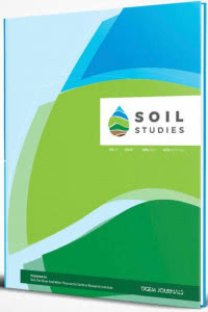Halil KON, Lina AL BITAR, Hailemelekot KIDANE, Mulugheta SOLOMON, Justyna WIECZYNSKA, Sereen BOU ZEİN EL DEEN
Effects of Different Organic Soil Amendments on Yield Parameters of Brassica rapa L. subsp. sylvestris
Öz Brassica rapa L. subsp. sylvestris is one of the widely consumed vegetable in Puglia region of Italy. An experiment was conducted in experiment field of CHIEAM The Mediterranean Agronomic Institute of Bari (IAMB) to assess the effects of different organic amendments on yield parameters of turnip. Amendments used (a) coffee chaff compost, (b) coffee chaff (raw material), (c) control, (d) the commercial organic fertilizer. The rates of application were 6.3 tons ha-1 for coffee chaff compost, 7.5 tons ha-1 for coffee chaff and 9.3 tons ha-1 for the commercial organic fertilizer. The result indicated that the commercial organic fertilizer had highest values on number of leaves, plant height, fresh weight, dry weight and marketable yield (p
Anahtar Kelimeler:
Brassica rapa L. subsp. sylvestris; coffee chaff; compost; organic applications; yield
___
Agehara S, Warncke D D (2005). Soil moisture and temperature effects on nitrogen release from organic nitrogen sources. Soil Science Society of America Journal, 69: 1844–1855.Bradstreet R B (1965). The Kjeldahl Method for Organic Nitrogen. New York, NY: Academic Press Incorporated.
Castillo A E, Quarín S H, Iglesias M C (2002). Caracterización química y física de compost delombrices elaborado a partir de residuos orgánicos puros y combinados. Agricultura Técnica, 60: 74-79.
Ceglie F G, Erriquens F G, Verrastro V (2009). Composting of Coffee By-Products. Environmental Threats in the Mediterranean Region: Problems and Solutions Session 1. Agricultural, domestic and industrial wastes. October 8 - 11, Bari- Italy.
Chadwick D R, John B, Pain B, Chambers J, Williams J (2000). Plant uptake of nitrogen from the organic nitrogen fraction of animal manures: a laboratory experiment. The Journal of Agricultural Science, 134 (2): 159-168.
Chaves B, De neve S, Boeckx P, Van cleemput O, Hofman G (2004). Screening Organic Biological Wastes for Their Potential to Manipulate the N Release from N-Rich Vegetable Crop Residues in Soil. Agriculture Ecosystem and Environment, 111: 81–92.
Chèneby D, Nocolardot B, Godden B, Penninckx M (1994). Mineralization of composted N-labelled farmyard manure during soil incubations. Biological Agriculture and Horticulture, 10: 255– 264.
De neve S, Saez S, Chaves G, Daguilar B, Sleutel S, Hofman G (2004). Manipulating N Mineralization from High N Crop Residues Using On- And Off-Farm Organic Materials, Soil Biology & Biochemistry, 36: 127–134.
European Coffee Federation – European Coffee Report (2011). Thirty-second issue of the ‘European Coffee Report’. August 2011.
Fox R H, Myers R J K , Vallis I (1990). The Nitrogen Mineralization Rate of Legume Residues in Soil as Influenced by their Polyphenol, Lignin, and Nitrogen Contents. Plant Soil, 129: 251-259.
Hadas A, Portnoy R (1997). Rates of decomposition in soil and release of available nitrogen from cattle manure and municipal waste composts. Compost Science & Utilization, 5 (3): 48–54. doi:http://dx.doi.org/10.1080/1065657X.1997.10701885.
Hernández A, Castillo H, Ojeda D, Arras A, López J, Sánchez E (2010). Effect of vermicompost and compost on lettuce production. Chilean Journal of Agricultural Research, 70(4): 583- 589.
Ibrahim M, Hassan A, Iqbal M, Valeem E E (2008). Response of wheat growth and yield to various levels of compost and organic manure. Pakistan Journal of Botany, 40(5): 2135-2141.
Kowalchuk G, Naoumenko Z, Derikx P, Felske A, Stephen J, Arkhipchenko I (1999). Molecular analysis of ammonia-oxidizing bacteria of the β subdivision of the class proteobacteria in compost and composted materials. Applied Environment Microbiology, 65: 396-403.
Lampkin N (1990). Organic farming. Farming press books. Ipswich. United Kingdom.
Millner P D, Sikora L J, Kaufman D D, Simpson M E (1998). Agricultural uses of biosolids and other recyclable municipal residues. In: W.D. Kemper P.D. Millner J.F. Power and R.F. Korcack (Eds.), Agricultural Uses of Municipal, Animal and Industrial Byproducts. Conservation Research Reports, USDA Agricultural Research Survey, Washington, DC., pp. 9-44.
Nelson D W, Sommers L E (1982). Total carbon, organic carbon, and organic matter. In ‘Methods of soil analysis’. (Eds AL Page, RH Miller, DR Keeney) pp. 539–579. (American Society of Agronomy Inc., Soil Science Society of America Inc.: Madison, WI)
Olsen S R, Cole C V, Watanabe F S (1954). Estimation of Available Phosphorus in Soils by Extraction with Sodium Bicarbonate. USDA Circular No. 939, US Government Printing Office, Washington DC.
Pansu M, Thuries L (2003). Kinetics of C and N Mineralization, N Immobilization and N Volatilization of Organic Inputs in Soil. Soil Biology & Biochemistry, 35: 37-48.
Rodríguez D N, Cano R P, Figueroa V U, Palomo G A, Esteban F C, Álvarez R V (2008). Producción de tomate en invernadero con humus de lombriz como sustrato. Revista Fitotecnia Mexicana, 3: 265-272.
- ISSN: 2146-7072
- Yayın Aralığı: Yılda 2 Sayı
- Yayıncı: Toprak Gübre ve Su Kaynakları Merkez Araştırma Enstitüsü
Sayıdaki Diğer Makaleler
Havva ŞENDEMİRCİ, Ahmet KORKMAZ, Güney AKINOĞLU
Ali İMAMOĞLU, Muhammed BAHADIR, Orhan DENGİZ
Halil KON, Lina AL BITAR, Hailemelekot KIDANE, Mulugheta SOLOMON, Justyna WIECZYNSKA, Sereen BOU ZEİN EL DEEN
Rainwater Harvesting for Urban Ecology: Mustafa Uysal Park Case
Zehra AYTAÇ, Nurdilek GÜLMEZOĞLU, İmren KUTLU, İnci TOLAY
Tekirdağ Merkez İlçesindeki Bazı Akarsu Yataklarındaki Toprakların Özellikleri
